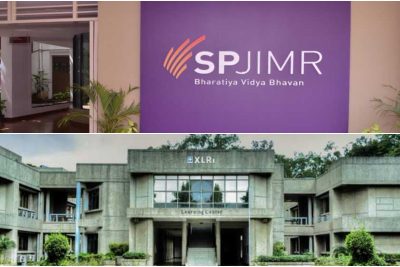SPJIMR and XLRI are considered to be two of the top b-schools in India. Their flagship programmes in post-graduation are comprehensive and all the top recruiters go to both the institutes for placements. Although XLRI is primarily known for its PGDM (HRM) course, we will be comparing it’s PGDM (BM) course with SPJIMR’s PGDM course. We have compiled a list of key differences between the two programs to help you with your decision. Aspirants must, however, make a choice as per their priorities, interests and goals.

SPJIMR - PGDM
Fees: Rs. 16,00,000 (this fee includes tuition fee, basic hostel/accommodation and Global Fast Track. It does not include the cost of travel, boarding, lodging, visa, insurance and incidentals for Global Fast Track.)
Electives Offered: 
1. Finance
2. Information Management
3. Marketing
4. Operations & Supply Chain
Total Intake: The programme can admit a total of 240 students. Also, 36 seats are available for PIOs, OCIs and foreign nationals. The program can take in a maximum of 276 students.
Selection: The students are selected on the basis of a composite score, which considers the applicant’s profile, academic record, scores in entrance tests (CAT/XAT/GMAT), the relevance of work experience (optional) and the aspirant's performance in the two rounds of
group interviews.
Location: The SPJIMR campus is located in Mumbai, the commercial capital of India. Mumbai houses important financial institutions such as the Reserve Bank of India, Bombay Stock Exchange, National Stock Exchange, and SEBI. It's also home to the headquarters of a lot of leading Indian corporate companies and multinational corporations. Mumbai, a global financial hub, offers students and professionals limitless business opportunities for growth and development. This obviously gives SPJIMR an edge when it comes to the location.
Placements: You can check out the final placement report of SPJIMR
here.
Autumn Internship: SPJIMR is probably the only b-school in India that has an autumn internship program instead of the conventional summer internships. Unlike other b-school students, SPJIMR students go for internships after choosing their specialisation. The students sit for interviews with companies and profiles that they are interested in. The advantage is that, by the time they go for their internship, they have studied a few subjects related to the specialisation and hence, are more prepared for the job. This gives them an opportunity to them for executing their theoretical knowledge at work.
USP: Their NCL (Non-Classroom Learning) program is designed to ensure the holistic development of the students.
Infrastructure: The campus of SPJIMR is spread over an expanse of 45 acres. It is equipped with modern amenities. The campus offers to its students' residential facilities, cafeterias, classrooms and learning centres. These include a library, an IT Centre, an Amphitheatre and an Executive Training Centre with audio and video equipment and a 24x7 wireless connection. The sports and entertainment facilities that the institute offers include an Open Air Theatre, playing fields and jogging tracks. The campus also has a lake, a cultural centre, a Botanical Garden, YogKutir and the Institute of Holistic Health Sciences.
Campus Life: SPJIMR students are given an opportunity for all-round development while on-campus. There are around 15 – 20 committees which work in different areas such as placements, cultural, social awareness, etc. and it’s mandatory for all the students to be a part of such committees. PGDM students have an option to participate in Ojas, the cultural fest, and SPrint, which is the sports fest. GASP (Guild of Actors at SPJIMR) is an annual event where students volunteer to produce a play. It’s a student-driven event.
Exchange Program: The Global Fast Track (GFT) is a mandatory program at SPJIMR that enables students to travel to top b-schools in the USA for a 3-week course, which is related to their specialisation. There’s also the IntEx (International Exposure) Program in the second year where the college sends students on an exchange program to countries like Japan, USA, etc. Students from Germany, France, Singapore and other foreign universities come to SPJIMR for the same.
Alumni Involvement: The AlCom (Alumni Committee) of SPJIMR is responsible for engaging with the alumni for various events that take place on the campus. They organise multiple formal and informal interactions between alumni and current batch throughout the year. They also organise the Annual Alumni Meet along with reunions. Read more stories about SPJIMR alumni
here.
XLRI - PGDM (BM)
Fees: Rs. 23,00,000
Electives Offered: During the second year a student is required to do 14 (fourteen) elective courses from the following areas:
1. Economics
2. Finance
3. Information Systems
4. Marketing
5. Production, Operations & Decision Sciences
6. Strategic Management
You can find the list of electives
here.
Total Intake: The current batch size is of 180 students.
Selection: The admission of students is done considering their professional experience, academic record, GMAT/ XAT scores, essays and performance in personal interviews.
Location: XLRI is located in Jamshedpur, which is also known as Tatanagar as it’s the city where Jamshedji Tata had first established Tata Steel. Jamshedpur is not easily accessible as it doesn’t have a civil airport of its own yet. Hence some of the companies and guest lecturers find it difficult to visit Jamshedpur.
Placements: You can check out the final placements 2017 report of XLRI
here.
Summer Internship: XLRI conducts summer placements every year for its first-year students. The process has the participation of 120+ companies offering roles across domains including consulting, finance, sales and marketing, operations, business development (BM), human resources (HR) and industrial relations (IR). You can read the detailed report of 2017’s Summer Placements
here.
USP: XLRI has a Behavioural Lab where students conduct research on consumer behaviour and functioning of the individual brain.
Infrastructure: The XLRI campus spans over 50 acres and boasts of a state-of-the-art academic learning centre. The learning centre has eight air-conditioned amphitheatre classrooms, syndicate rooms, a computer centre with latest servers and workstations, and an air-conditioned examination hall. The campus has a library, IT facilities with Wi-Fi connectivity, auditoriums, and offers sporting and recreational facilities along with student and staff residences.
Campus Life: There are plenty of activities for students to take part in at XLRI. From student societies to festivals like Ensemble, students participate in a wide range of co-curricular activities. The institute also provides counsellors for students. In spite of the rigorous academics at XLRI, the students excel in co-curricular as well. A two-day team building programme is compulsory for the students, usually at the beginning of the course which includes adventure activities and includes overnight camping in tents. The course consists of a village exposure programme wherein the students stay in villages, interact with the locals there, and study some of the practices and issues related to rural India.
Exchange Program: XLRI is a part of the University Network for Social Entrepreneurship, and it has international exchange programs with the other partner institutions.
Alumni Involvement: The Institute keeps in touch with its Alumni through newsletters and major events that it organizes throughout the year. The Alumni Homecoming is organized during the third weekend of November every year. Alumni who have completed 25 years of graduation celebrate their silver jubilee around Christmas time. They also help in arranging for guest lectures at XLRI. The current students and alumni are informally connected through a Facebook page and the members of this group are always eager to help each other.
* This article is based solely on secondary research.
If you notice any discrepancies or have any feedback, please let us know in the comments section.
*This article was last edited on 26th May 2020.




